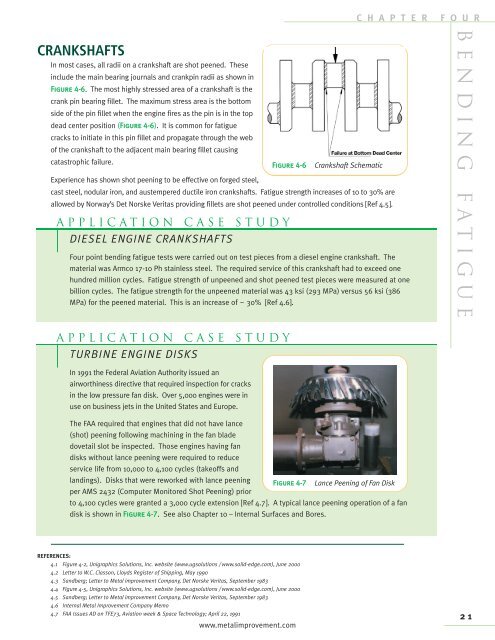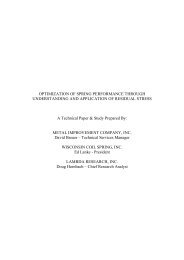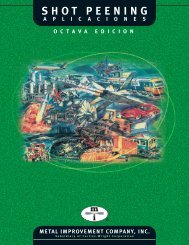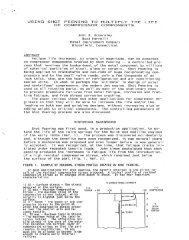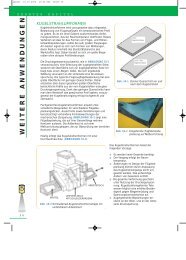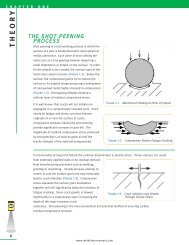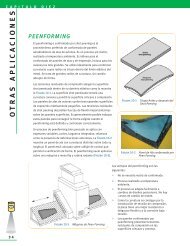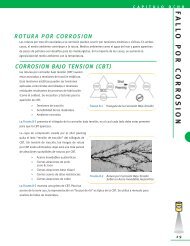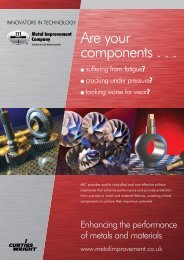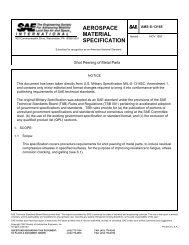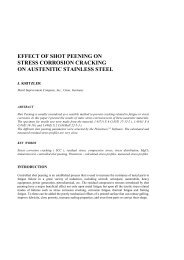MIC Green Book
MIC Green Book
MIC Green Book
You also want an ePaper? Increase the reach of your titles
YUMPU automatically turns print PDFs into web optimized ePapers that Google loves.
CRANKSHAFTS<br />
In most cases, all radii on a crankshaft are shot peened. These<br />
include the main bearing journals and crankpin radii as shown in<br />
Figure 4-6. The most highly stressed area of a crankshaft is the<br />
crank pin bearing fillet. The maximum stress area is the bottom<br />
side of the pin fillet when the engine fires as the pin is in the top<br />
dead center position (Figure 4-6). It is common for fatigue<br />
cracks to initiate in this pin fillet and propagate through the web<br />
of the crankshaft to the adjacent main bearing fillet causing<br />
catastrophic failure.<br />
Experience has shown shot peening to be effective on forged steel,<br />
Figure 4-6 Crankshaft Schematic<br />
cast steel, nodular iron, and austempered ductile iron crankshafts. Fatigue strength increases of 10 to 30% are<br />
allowed by Norway’s Det Norske Veritas providing fillets are shot peened under controlled conditions [Ref 4.5].<br />
Application Case Study<br />
DIESEL ENGINE CRANKSHAFTS<br />
Four point bending fatigue tests were carried out on test pieces from a diesel engine crankshaft. The<br />
material was Armco 17-10 Ph stainless steel. The required service of this crankshaft had to exceed one<br />
hundred million cycles. Fatigue strength of unpeened and shot peened test pieces were measured at one<br />
billion cycles. The fatigue strength for the unpeened material was 43 ksi (293 MPa) versus 56 ksi (386<br />
MPa) for the peened material. This is an increase of ~ 30% [Ref 4.6].<br />
Application Case Study<br />
TURBINE ENGINE DISKS<br />
In 1991 the Federal Aviation Authority issued an<br />
airworthiness directive that required inspection for cracks<br />
in the low pressure fan disk. Over 5,000 engines were in<br />
use on business jets in the United States and Europe.<br />
The FAA required that engines that did not have lance<br />
(shot) peening following machining in the fan blade<br />
dovetail slot be inspected. Those engines having fan<br />
disks without lance peening were required to reduce<br />
service life from 10,000 to 4,100 cycles (takeoffs and<br />
landings). Disks that were reworked with lance peening<br />
per AMS 2432 (Computer Monitored Shot Peening) prior<br />
Figure 4-7 Lance Peening of Fan Disk<br />
to 4,100 cycles were granted a 3,000 cycle extension [Ref 4.7]. A typical lance peening operation of a fan<br />
disk is shown in Figure 4-7. See also Chapter 10 – Internal Surfaces and Bores.<br />
REFERENCES:<br />
4.1 Figure 4-2, Unigraphics Solutions, Inc. website (www.ugsolutions / www.solid-edge.com), June 2000<br />
4.2 Letter to W.C. Classon, Lloyds Register of Shipping, May 1990<br />
4.3 Sandberg; Letter to Metal improvement Company, Det Norske Veritas, September 1983<br />
4.4 Figure 4-5, Unigraphics Solutions, Inc. website (www.ugsolutions / www.solid-edge.com), June 2000<br />
4.5 Sandberg; Letter to Metal improvement Company, Det Norske Veritas, September 1983<br />
4.6 Internal Metal Improvement Company Memo<br />
4.7 FAA Issues AD on TFE73, Aviation week & Space Technology; April 22, 1991<br />
www.metalimprovement.com<br />
C H A P T E R F O U R<br />
BENDING FA TIGUE<br />
21


